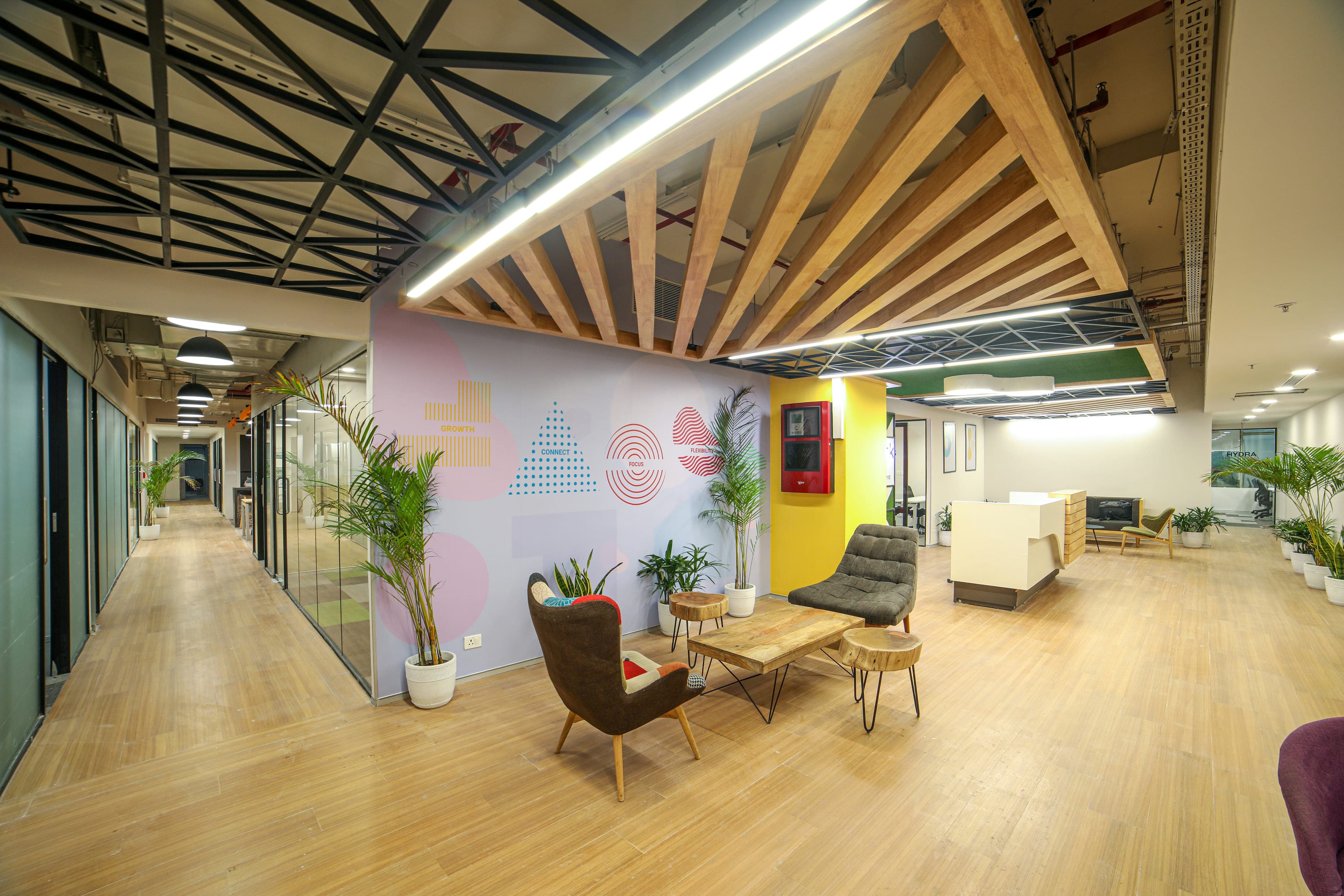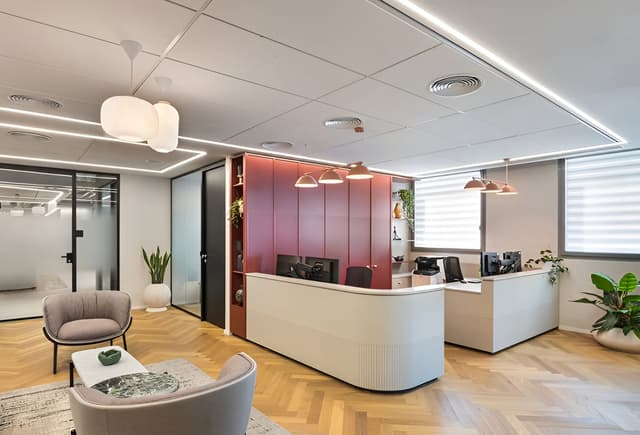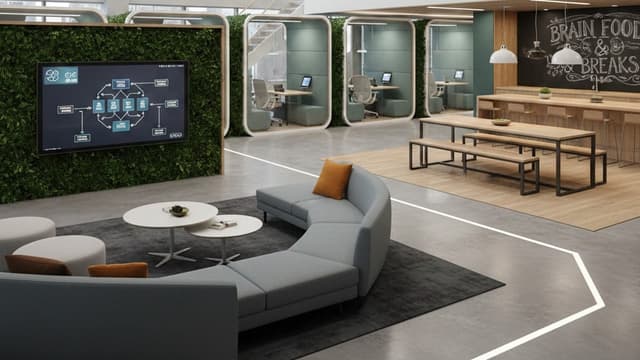The Future of Workspace Design: Cubicles Vs. Collaborative Hubs in 2024
The corporate office interior design has come a long way. In case, you do not match up, you can try and continue to evolve and adapt to the latest workspace design accordingly. As office design is an ever-evolving concept, the balance of maintaining privacy and collaboration is an art. By choosing Daftar Decor, we help you create an environment where your business can thrive and move to its full potential

The corporate world is ever-evolving. This is why the corporate office interior design is always changing.
Well, for instance, traditional cubicles are being replaced by collaborative hubs. In 2024, the workspace is becoming more dynamic and encouraging office environments with flexibility, innovation, and employee well-being. Also, the workplaces are designed keeping different aspects in mind such as functionality, collaboration, and state-of-the-art technology.
However back in the 20th century, cubicles were the hallmark of office design. But now they are often seen as small isolated spaces and limited collaborative opportunities.
The rise of open-plan offices
When in the late 90s and early 2000s, the famous cubicle design began to fall in IT office interior design. Moreover, companies such as Facebook and Google made these designs popular which were wall-less and designed to encourage collaboration, communication, and a sense of community.
The collaborative hubs facilitated teamwork and made the office less confining. These transformative trends offer insights and solutions that enhance your overall office space.
The Evolution of Office Designs in 2024
In 2024, office designs have undergone a transformative journey. They are adapting to dynamic work cultures, technological advancements, and the evolving needs of employees. This is shaping environments that prioritize collaboration, flexibility, and well-being.
Collaborative workspaces
Cubicles gave way to collaborative and open spaces that are the epitome of teamwork and interaction.
This is important for enhanced productivity and making a more modern and team-centric office.
Flexibility
Traditional office layouts or cubicles felt more rigid and paved the way for a more flexible environment. It gave access to an innovative environment.
Open floor plans with modular furniture and specially designed collaboration zones such as breakout spaces are now important aspects of modern space design.
Most corporate office interior designers emphasise forming an environment that adapts well to the different needs of employees and values collaboration.
Technology Integration
Well, you know what is inseparable? The blend of work and technology. Technology has made its way into the office and transformed it into a smart office. Today, we can witness state-of-the-art technology that streamlines communication and enhances productivity.
With seamless video conferencing to interactive displays, technology integration is redefining the way we interact with our work environments.
This approach helps in increasing efficiency and reflects the commitment to stay ahead in the modern digital world.
Prioritising Employee Well-being
The leaders today know the importance of employee well-being and that is why they are emphasising it as well. The overall office design is now focusing on creating an environment that promotes happiness and health.
Most of the business environments today are adopting biophilic design principles. Through this design, they incorporate the elements of nature into the office settings and thus gain popularity.
With the abundance of nature’s elements and ergonomic furniture, the spaces contribute to more satisfied and healthier employees.
Integrating remote work capabilities
As more employees like to work from home after the pandemic, the offices are changing. The workspace designers are now designing spaces where you can work together and also work from anywhere. This is also called as the hybrid culture.
This means although there is a workspace for the team to work, you can still do your job from home or another place if you need to. This new way of working has changed the job market completely.
Eco-friendly and sustainable practices
Also, offices are starting to care more about being eco-friendly. They use materials that are good for the environment, like stuff that doesn't pollute.
They also use systems that don't waste energy, and they design the office in ways that help the planet.
Companies want to cut down on how much they harm the environment, and how they design their offices is part of that.
Comparison of Cubicles and Collaborative Hubs
Let us understand how cubicles and collaborative spaces impact productivity, employee satisfaction, collaboration, and cost.
Productivity
Cubicles have been in offices for decades. They have offered employees their own defined space and allow them to focus on tasks without too many distractions.
This setup is beneficial for tasks that need deep concentration or privacy.
Some people argue that cubicles can feel isolating and can lead to a lack of motivation or creativity.
On the other hand, collaborative hubs promote interaction and idea-sharing among employees.
These open spaces encourage spontaneous conversations and brainstorming sessions. This often leads to innovative solutions. Although constant activity and noise in collaborative hubs may distract some employees.
Employee Satisfaction
Employee satisfaction is crucial for maintaining a positive work environment and retaining talent. Cubicles provide employees with a sense of privacy and ownership over their space. This contributes to the employee satisfaction.
Some employees may feel confined or disconnected from their colleagues in cubicle setups.
Collaborative hubs promote a sense of community and belongingness among employees. The open layout encourages interaction and fosters a collaborative culture. This results in enhanced morale and engagement.
Employees often appreciate the opportunity to collaborate and socialize with their peers in these environments. Those who prefer privacy may find the lack of personal space in collaborative hubs and it can get challenging.
Collaboration
Collaboration is essential for innovation and achieving business goals. Cubicles are individualised spaces.
Thus, communication barriers may arise and this makes it challenging for teams to collaborate effectively.
These hubs provide a space where employees can easily communicate and collaborate. It is an open layout that encourages teamwork and idea-sharing and a culture of collaboration within the organization.
Cost Considerations
Both cubicles and collaborative hubs can be expensive when it comes to cost. Cubicle office designs require individual workstations, partitions, and furniture.
This adds up to initial investment and maintenance costs. The cubicles may require more space per employee. It leads to increasing real estate expenses as well.
Collaborative hubs require fewer partitions and individual workstations. It leads to potential cost savings in terms of furniture and space utilization.
Whereas, designing and furnishing collaborative hubs with numerous amenities such as whiteboards, comfortable seating, and technology may incur additional expenses too.
In the end
The corporate office interior design has come a long way. In case, you do not match up, you can try and continue to evolve and adapt to the latest workspace design accordingly.
As office design is an ever-evolving concept, the balance of maintaining privacy and collaboration is an art. By choosing Daftar Decor, we help you create an environment where your business can thrive and move to its full potential.
Our team will help you go beyond expectations and embrace the latest trends in workspace design. Contact us and get on the journey towards an inspired and transformed workspace.
Your Office, Your Way! Let’s Design it Together


